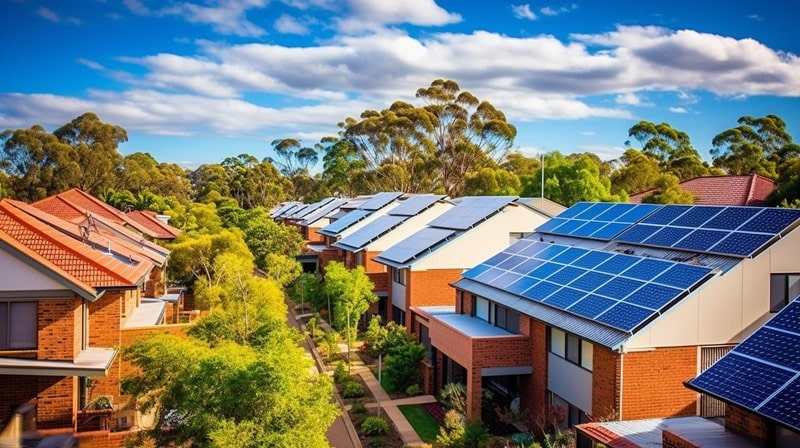The Rise of Green Energy and its Market Implications
Australia’s energy landscape is undergoing a significant transformation as renewable energy sources, particularly rooftop solar, gain traction. Daytime power prices have recently dipped into negative figures, implying that generators are essentially paying to produce energy. This trend, often referred to as “price cannibalisation,” has been observed more frequently as green energy’s share in Australia’s primary electricity system touched an unprecedented 70% this week.
The increasing reliance on green energy is reshaping the market dynamics. Traditional power generation methods are grappling to find their footing amidst the renewable surge. As the shift towards sustainable energy continues, the industry must adapt to ensure a balanced and efficient energy market.
The Solar Surge and its Effect on Wholesale Prices
The national electricity market spanning the eastern states witnessed wholesale power prices plummeting to -$64 per megawatt hour last Saturday. This drastic drop was attributed to the influx of energy from millions of rooftop solar panels. Such occurrences are more pronounced during sunny, mild conditions, especially on weekends when solar production peaks, but electricity demand remains relatively subdued.
The interplay between high solar output and low demand is creating a unique challenge for the energy market. Innovative solutions are required to balance supply and demand, ensuring that the grid remains stable and consumers continue to receive reliable power.
The Challenges for Large-Scale Solar Farms
Gridcog, an energy software firm, highlighted that while the market is being increasingly influenced by rooftop solar, large-scale solar farms are bearing the brunt of this trend. The decentralized nature of rooftop solar means it often operates outside the purview of the market operator. Consequently, utility-scale solar plants sometimes have to reduce their generation or even shut down during peak solar output hours to avoid incurring costs.
This phenomenon underscores the need for a more adaptive energy market. The unpredictable nature of renewable energy sources demands a system that can ensure stability and profitability for large-scale producers, while also accommodating the growing influence of decentralised solar power.
The Growing Dominance of Rooftop Solar
With over 3.3 million Australian homes now equipped with solar panels, the trend is set to intensify. Predictions suggest that this number could nearly double by 2032. Dr. Dylan McConnell from the University of New South Wales emphasised that rooftop solar is no longer a peripheral player but is central to the grid’s operation.
In regions like South Australia, there are instances where rooftop solar production surpasses the entire state’s demand. The rapid adoption of rooftop solar is a testament to its efficiency and affordability. However, it also brings to light the challenges of integrating such a dominant energy source into the existing grid without causing disruptions.
The Need for a More Dynamic Power System
Dr. Alex Wonhas, a former electricity system planner, pointed out that as more rooftop solar is integrated into the system, record lows in grid power demand are being consistently surpassed. While household solar has been a standout in Australia’s energy transition, it presents challenges. The power system of the future will need to be more dynamic and orchestrated, accommodating both renewable and conventional generators.
This shift will require significant investments in infrastructure, technology, and policy reforms. A seamless transition to a more sustainable energy future is crucial for Australia to meet its environmental goals and ensure energy security for its residents.
The Path Forward: Solutions and Strategies
Christian Zuur from the Clean Energy Council believes that curtailing generation from wind farms and large-scale solar projects is a missed opportunity to utilise zero-cost energy. To harness this energy effectively while maintaining grid stability, there’s a pressing need for more pumped hydro and grid-scale battery storage.
Dr. McConnell suggests that encouraging energy consumption during daylight hours could help absorb the surplus solar energy, benefiting both consumers and the broader energy market. Policy interventions, technological advancements, and consumer awareness campaigns can play a pivotal role in optimising the use of renewable energy, ensuring that Australia remains at the forefront of the global green energy movement.
FAQs:
- Why are daytime power prices going negative? Due to the surge in renewable energy, especially rooftop solar, which leads to an oversupply during peak production hours.
- How is “price cannibalisation” affecting the energy market? It results in large-scale solar farms reducing their output or shutting down to avoid costs during peak solar hours.
- How many Australian homes currently have solar panels? Over 3.3 million homes, which is predicted to nearly double by 2032.
- What challenges does the growth of rooftop solar present? It can lead to an oversupply of energy during peak production hours, affecting the viability of large-scale solar projects.
- How can the challenges of the energy transition be addressed? By increasing energy storage solutions, encouraging consumption during daylight hours, and possibly government interventions to support utility-scale solar farms.


Leave a Reply